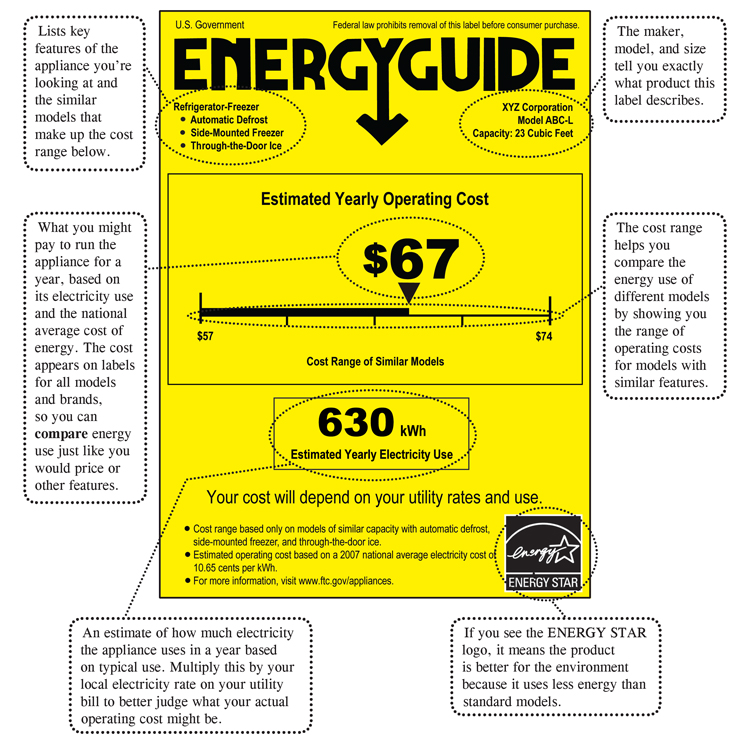Shopping for Home Appliances? Use the EnergyGuide Label
Going shopping for a new appliance? Make sure you look for the EnergyGuide label, the yellow tag you’ll find attached to most appliances. It tells how much energy an appliance uses and makes it easier to compare the energy use of similar models. Appliances that use less energy are better for the environment; and the more energy efficient an appliance is, the less it costs to run, and the lower your utility bills might be.
Why Should You Use the EnergyGuide Label?
If you’ve shopped for appliances, you’ve probably seen the bright yellow EnergyGuide label that tells you how much energy each appliance uses. But did you know that the EnergyGuide label can help you compare the energy use of similar models as you shop?
That’s important because the more energy efficient an appliance is, the less it costs to run, and the lower your utility bills might be. That might make you more willing to pay a little more up-front. Using less energy is good for the environment, too; it can reduce air pollution and help conserve natural resources.
How Do You Use the EnergyGuide Label?
This sample label explains how to use the label as you shop.
The label includes:
- The make, model, and size – so you know exactly what product this label describes.
- A lists of key features – both of the appliances you’re looking at and the similar models that make up the cost range below.
- The cost range of competitors – this helps you compare the energy use of similar models by showing you the range of operating costs for models with similar features.
EnergyGuide Questions
Do all appliances have EnergyGuide labels?
No, some appliances do not have EnergyGuide labels.
The haves: clothes washers, dishwashers, refrigerators, freezers, televisions, water heaters, window air conditioners, central air conditioners, furnaces, boilers, heat pumps, and pool heaters.
The have nots: ranges, ovens, clothes dryers, humidifiers, and dehumidifiers.
Is it safe to assume the estimated operating cost is close to what I’ll actually pay each year?
No, it is an estimate. The cost on the label is based on a national average price for electricity. Your rate depends on where you live. How much electricity the appliance uses depends on how you use the appliance.
What if there’s no EnergyGuide label on an appliance?
Check to see if it’s hanging inside. If a label is missing and the retailer can’t help you, visit the manufacturer’s website. Or, look to see if the retailer has posted the label online.
Are all EnergyGuide labels the same?
No, they are appliance specific. Furnace labels don’t have operating costs; dishwasher labels have two costs — one for people who use electric water heaters, and another for people who use natural gas water heaters. Still, all EnergyGuide labels give you a way to compare the energy use of similar appliances.
Are the national average electricity cost and the cost range always up-to-date?
These figures are updated every five years. This helps all manufacturers base their estimated costs on the same electricity rate and usage patterns. But it also means that the rate used for EnergyGuide labels won’t always reflect electricity prices at the time. It also means it’s possible a newer model’s operating cost won’t be reflected in the cost range. However, the model would still have its own EnergyGuide label.
How can you find out more about the ENERGY STAR program?
To earn the ENERGY STAR, a product must meet energy efficiency guidelines set by the U.S. Environmental Protection Agency (EPA) and U.S. Department of Energy (DOE). To learn more, visit energystar.gov.
Your Shopping Strategy
Ready to shop? Don’t forget to:
- Measure. Make sure the space you’ve got for an appliance is big enough to fit it, including room to open the door or lid fully and appropriate clearance for ventilation.
- Compare performance. Decide which features are important to you, and ask about how various models operate: Are they noisy? What safety features do they have? What about repair histories? How much water do they use? Expert reviews might be helpful. Online reviews also can help you spot common complaints, but don’t put all your faith in any one review. Try searching for the company or product’s name with words like “review” or “complaint.”
- Look at the energy use. This is where the EnergyGuide label comes in handy. It lets you compare the energy use of similar models. The difference on your monthly utility bill can be significant, especially when considered over the life of an appliance, and might make up for a higher purchase price on a more efficient model.
- Ask about special energy efficiency offers. Ask your salesperson or local utility for information on cash rebates, low-interest loans, or other incentive programs in your area for energy-efficient product purchases and how to qualify. Or visit DOE’s Energy Saver site at energysavers.gov.
For More On Lowering Your Monthly Energy Bill
Buying an energy-efficient appliance is one way you might get the most from the energy you use. Visit DOE's Energy Saver site at energysavers.gov and ENERGY STAR at energystar.gov for more ways to save.




